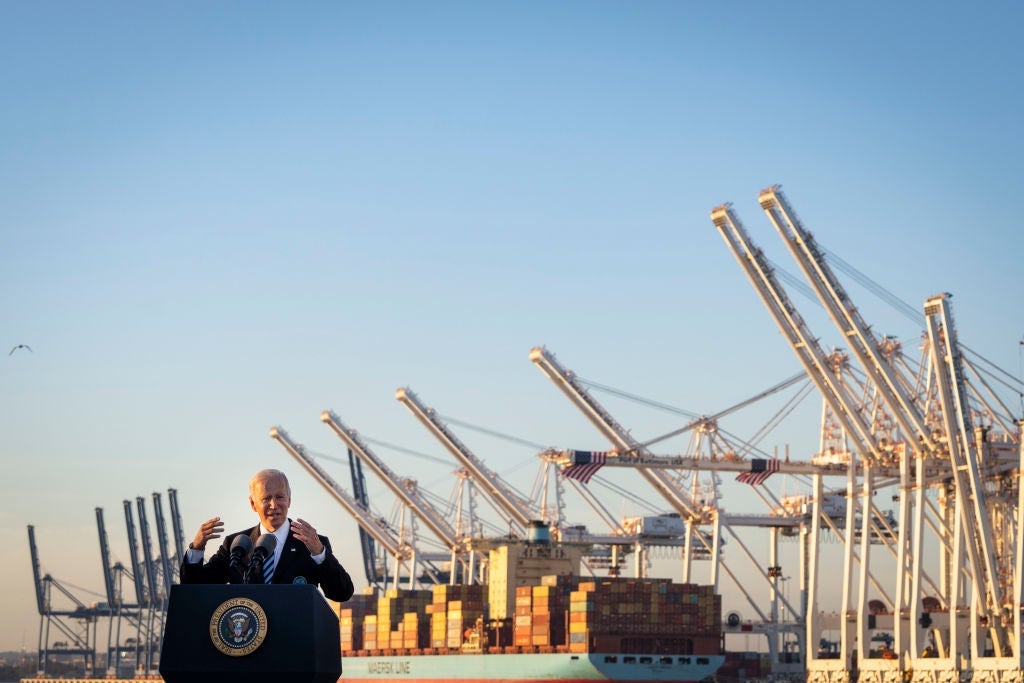
The $1.2trn infrastructure bill passed by the US House of Representatives on 5 November 2021 was first and foremost a political achievement.
It could conceivably be the only major piece of legislation President Joe Biden passes before the midterm elections in 2022, given the entrenched partisan culture plaguing US politics. That the bill was passed with bipartisan support makes it something of a modern miracle.
The House of Representatives passed the Infrastructure Investment and Jobs Act by 228 votes to 206, with the support of 13 Republican representatives.
On those terms alone the legislation is a significant accomplishment, but will it fix all of the problems that have dogged US infrastructure in recent decades?
The US is crumbling
The American Society of Civil Engineers rated US infrastructure just C+ in its latest report card, published in October 2021. The assessment is an embarrassment for a global superpower, with the report highlighting how there is a water main break somewhere in the country every two minutes, and that 43% of US public roads are in poor or mediocre condition.
Any first-time foreign visitor arriving at US airports or using the country’s public transport system is likely to be surprised at the disrepair much of the country’s transport is in, and a significant overhaul has been long overdue.
How well do you really know your competitors?
Access the most comprehensive Company Profiles on the market, powered by GlobalData. Save hours of research. Gain competitive edge.

Thank you!
Your download email will arrive shortly
Not ready to buy yet? Download a free sample
We are confident about the unique quality of our Company Profiles. However, we want you to make the most beneficial decision for your business, so we offer a free sample that you can download by submitting the below form
By GlobalData“This is the biggest infrastructure spending bill since the Great Depression and will enable historic investments in core infrastructure,” says Mona Dajani, global co-head of energy and infrastructure projects at international law firm Pillsbury Winthrop Shaw Pittman.
“We in the US are woefully behind Europe and Asian countries such as Japan and South Korea on infrastructure investment, and it has needed to be addressed for a long time,” she adds.
The funding this infrastructure bill will provide has been widely welcomed by investors, developers and advisers working in the sector. Yet the federal government has little control over the delivery of major infrastructure projects, and it is not guaranteed that government funding will catalyse the substantial private investment needed to deliver them.
“The government can’t deliver this very ambitious programme unless it forms partnerships with the private sector because [the state] doesn’t have the resources, innovation, ideas and manpower to deliver it on its own,” says David Baxter, a sustainable public-private-partnership (PPP) and development consultant.
What is in the bill?
Although the final bill has a smaller spending commitment than Biden’s original infrastructure plan, its breadth is still huge. Roads, bridges and other major infrastructure projects are the biggest recipients of funding, with a commitment of $110bn, but the bill will also provide funding for a range of other services including broadband connectivity, water system upgrades, improvements to the electricity grid and climate change mitigation measures.
These funds will be made available through federal programmes, such as the Transportation Infrastructure Finance and Innovation Act (Tifia), but the federal government has limited control on how they are spent. Almost all infrastructure projects are procured at the state or municipal level, with local authorities deigned responsible for proposing and delivering them.
What investors, both domestic and foreign, will want to see is states and cities developing a large and deliverable pipeline of infrastructure projects that they can compete for.
Manuel Zafra Solas, senior investment director at Globalvia, says the legislation sends a strong message that there is real opportunity for private investors, but the nature of that opportunity is yet to be determined.
Globalvia is a Spain-based project investor and developer owned by pension funds OPTrust, PGGM and USS. It has been very active in the US roads sector over the past decade and is one of many foreign companies hoping to capitalise from this legislation.
“We will have to wait and see how this bill really impacts the project pipeline,” says Zafra Solas. “That will be determined by the individual states and municipalities, but we know they are working on this now.”
Beyond the funding headlines
Provisions in the bill may prove as important to successfully delivering projects as the funding. An attempt to streamline the permitting process could have a significant impact on project delivery.
“Permitting has been one of the key barriers to infrastructure development in the US,” says Zafra Solas. “You need to get the approval from so many agencies, and it is such a long process.”
Under the new legislation, all relevant government agencies will work at the same time, instead of conducting their due diligence consecutively, which could drastically reduce pre-construction preparation time.
There is also a hope that opportunities for PPPs (or P3s in American parlance), under which private and public sector parties share finance, construction, operations and maintenance responsibilities under a long-term contract, will be enhanced.
Tim Treharne, principal, advisory services, at professional services company Arup, says it is “delighted” at the passing of the bill and highlights the “opportunity for the funds made available by the bill to be amplified through the use of P3 procurement, which optimises procurements through an integrated approach and which is further facilitated in the bill, including by way of increases in Tifia [Transportation Infrastructure Finance and Innovation Act] lending”.
Any applicant under the Tifia or Railroad Rehabilitation & Improvement Financing programmes with project costs of more than $750m will now have to conduct a value-for-money analysis as part of their application.
Supporters of P3 say that it is often the best-value funding option for large infrastructure projects but has previously been rejected by many procuring authorities in the country in favour of more traditional building contracts.
“The value-for-money analysis is definitely to the benefit of P3,” says Zafra Solas. “It is not a silver bullet and will not be the best framework for every project, but P3 gives you a very long-term perspective on project life cycle and ESG factors. It is also very beneficial for complex projects, as it allows you to pass a layer of risk on to the private sector.”
The limited adoption of the P3 model in the US has been a block on more investment into the sector. Traditional infrastructure investors want certainty of revenues written into long-term contracts, which is what P3 is designed to provide.
Baxter is an adviser to the International Sustainability Resilience Centre, based in New Orleans, which advises on how P3 can help mitigate the worst impacts of climate change. He says PPPs can meet one of the key aims of the legislation – improving climate resilience – because the model is based on “risk management and risk allocation. If you are not at least acknowledging long-term climate risks, you are putting many projects in jeopardy.”
With winter storms in Texas and forest fires in California wreaking devastation in recent years, the impacts of climate change are now much harder to ignore. Baxter highlights how one of the architects of the legislation was Senator Bill Cassidy of Louisiana, a state that has been losing about 25 square miles of land per year due to rising sea levels.
Momentum at state level
Given how divided US politics is, and the attacks some of the Republicans who supported the bill have been subject to since its passing, there is a risk that Republican-run areas will be less enthusiastic in using the funds, particularly while a Democrat remains in the White House.
Dajani accepts this risk but argues that “you will never get something that 100% of people are happy with. I am confident that this bill with bring the US together more than it creates fissures.”
Zafra Solas says the private sector has a responsibility to actively work with all stakeholders to ensure these committed federal funds are successfully converted into completed projects. “The infrastructure bill has created momentum and you can see that at the state level,” she says.
“It is time for the private sector to be proactive and engage at every level, at the federal level, state level and city level, with all the stakeholders, to ensure we unlock private capital and realise projects that otherwise wouldn’t be feasible.”
This bill is just part one of an intended two-part Build Back Better Act, but the second $1.75bn section is subject to greater political opposition. Its funding would go towards a range of social programmes as well as supporting renewable energy projects through tax credits. A House vote has been delayed until the Congressional Budget Office has scored this part of the legislation.
Dajani says this second part is “perhaps even more critical” to the US economy than the infrastructure bill, given how important it is to stimulate investment in renewable energy and the energy transition.
The passing of Biden’s infrastructure bill is a monumental achievement for the president, but a lot of work remains to be done to ensure private investors can help make the country's infrastructure fit for a superpower.






